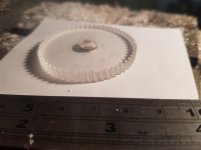I am posting this thread topic to see if there is any interest in this obscure practice.
The very mention of the subject seems to rattle cages and bring out some very thin skinned machinists like I was talking heresy
To summarise
Its a method of cutting gears without the complexity and cost of a manual dividing head and formed milling cutter or even worse a head geared to a mill spindle and using a hob cutter
Let me say up front that I have the greatest respect for the science of gear technology and its practitioners. Its a very complex subject and has some highly skilled manufacturers who hold much of the expertise that is well beyond the home hobbyist
What I propose for discussion and experimentation will in many ways tear up the rule book and start from scratch
This method has been used to make wrom gears and this is a well documented procedure with ample vids on YT. I dont propose to elaborate on the area save to say that making spur gears is no more than an extension of the method (which has got some bad press in the past mainly IMHO due to faulty implementation of the technique)
I have been experimenting in this area and have produced some encouraging results - even successes. I will offer to post pix and vids of my work and invite others to try the technique and report
Up front
This is a Cheap Charlie method that can knock out gears in minutes
These gears - at this stage wont be to accepted DP/Mod standards (yet) but they will make quasi involute forms and can be assembled into a meshing train that seems to work
At present the method only produces Mod 1(ish) 30PA pieces and is only suitable for light duty low power xmission on non ferrous mtls
These might suit a model maker or experimentalist. The wheels are likely only to work amongst themselves but that may not be an issues - for example making a set of change gears for an old lathe
I think the method can be extended to perform reliably to meet des criteria eg No of teeth, and predictable Pcd but it needs skill and experience
I welcome the participation of open minded machinists but I wont be producing reams of explanatory words as the convolutions of the subject will be one big turn off, put a picture is worth...............
and even better get your hands on when much will become clear
for me very much work in hand and I believe there are others on this board who have been down this path
Hope this doesnt start a forest fire
Robin (no affiliation to Batman)
The very mention of the subject seems to rattle cages and bring out some very thin skinned machinists like I was talking heresy
To summarise
Its a method of cutting gears without the complexity and cost of a manual dividing head and formed milling cutter or even worse a head geared to a mill spindle and using a hob cutter
Let me say up front that I have the greatest respect for the science of gear technology and its practitioners. Its a very complex subject and has some highly skilled manufacturers who hold much of the expertise that is well beyond the home hobbyist
What I propose for discussion and experimentation will in many ways tear up the rule book and start from scratch
This method has been used to make wrom gears and this is a well documented procedure with ample vids on YT. I dont propose to elaborate on the area save to say that making spur gears is no more than an extension of the method (which has got some bad press in the past mainly IMHO due to faulty implementation of the technique)
I have been experimenting in this area and have produced some encouraging results - even successes. I will offer to post pix and vids of my work and invite others to try the technique and report
Up front
This is a Cheap Charlie method that can knock out gears in minutes
These gears - at this stage wont be to accepted DP/Mod standards (yet) but they will make quasi involute forms and can be assembled into a meshing train that seems to work
At present the method only produces Mod 1(ish) 30PA pieces and is only suitable for light duty low power xmission on non ferrous mtls
These might suit a model maker or experimentalist. The wheels are likely only to work amongst themselves but that may not be an issues - for example making a set of change gears for an old lathe
I think the method can be extended to perform reliably to meet des criteria eg No of teeth, and predictable Pcd but it needs skill and experience
I welcome the participation of open minded machinists but I wont be producing reams of explanatory words as the convolutions of the subject will be one big turn off, put a picture is worth...............
and even better get your hands on when much will become clear
for me very much work in hand and I believe there are others on this board who have been down this path
Hope this doesnt start a forest fire
Robin (no affiliation to Batman)







 and then there are those of us who grew up driving both semis and farm tractors, as well as cars and bikes. I still do the semis, being that I work in a semi repair shop. So, gears are kinda "interesting".
and then there are those of us who grew up driving both semis and farm tractors, as well as cars and bikes. I still do the semis, being that I work in a semi repair shop. So, gears are kinda "interesting".